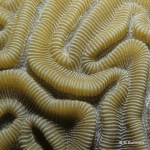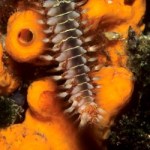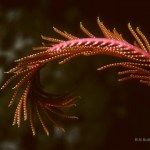macro photography
A reader asks:
I also have a MP-E lens with the MT-24EX flash unit. I was curious to know something I didnât see you mention in your recent blog post about this setup.
Could you share any technical points regarding how you achieve the visible backgrounds with that lens? In general, I get very nice shots with everything beyond the focused subject completely blacked out.
Since dark areas in photographs are the bits that aren't sending light to the camera, it follows that getting a visible backdrop means applying light behind the subject.
Earlier, I wrote that the black backdrop in insect…
Yesterday afternoon, perhaps tired of keeping up with the subzero temps, our furnace up and quit. We were able to keep the house somewhat above freezing until the repair guy installed the replacement bits this morning. We're all fixed now. But the outage wasn't without a bright side: the ice crystals on the windows grew especially wild:
Scleractinian corals, also known as stony corals -- or just hard corals -- are the primary reef builders in the oceans. Their polyps secrete calcium carbonate to form a skeleton. A minority of species live as single polyps, but most stony coral species are colonial, and the structures they build 'grow' over time. They form a myriad of shapes: mounds, branches, fingers, plates, and encrustations.
In several previous posts I discussed and displayed photos of a number of so-called soft corals, all of which are octocorals, i.e., their polyps have eight tentacles. Stony corals are…
They look like a cross between a caterpillar and a tricked out centipede. They crawl about with considerable agility, they are voracious feeders, and they certainly know how to defend themselves. Meet the Bearded Fireworm (Hermodice carunculata), a free-moving marine Polychaete worm.
This species is widely distributed from the Caribbean, throughout the warmer waters of the Atlantic Ocean (including Florida and the Bahamas), and all the way to the Mediterranean Sea. All of the images in this post were captured in the Mediterranean, in the waters around Cyprus and Greece.
H. carunculata is…
Even the clearest water has at least some particles suspended in it -- sand, silt, plankton, who knows what -- and most of the time, in most places, the water isn't really all that clear. In fact, during a plankton bloom or after a storm that has caused a lot of runoff, you might just as well leave your camera on the boat. Light from a camera strobe has a nasty habit of bouncing back from any particulate matter that it encounters between the camera lens and the subject. The result is the bane of underwater photography: backscatter. Your images will look as though they were taken in a…
For those of you accessible to central Illinois, I will be hosting a free insect photography workshop next Sunday at the University of Illinois Pollinatarium. The workshop is offered in celebration of the 3rd annual National Pollinator Week. Details are as follows:
Insect Photography Workshop
Free to the public
2:00 pm, June 28th, 2009
at the University of Illinois Pollinatarium (map)
Bring your camera, as this is a participatory event!
Solenopsis geminata, the tropical fire ant
The latest upload concerns three species in the subfamily myrmicinae that have been traveling about the globe with human commerce. Solenopsis geminata, the tropical fire ant, is the most worrying of these tramps, but the other two, Pheidole moerens and P. obscurithorax, are rather poorly known and probably merit more study than they receive. Click to visit the gallery.
Incidentally, if I'd known at the time that Solenopsis geminata confers hero status on their collectors, I'd defintely have spent more time pointing them out to…
Odontomachus meinerti trap-jaw ant, Argentina
One perk of being at a research university is the opportunity to shoot the various study organisms on campus. These subjects are interesting- they have to be, or they wouldn't be studied- and when the research goes public I get the chance to disseminate my photographs with the science media outlets that cover the story.
Among my favorite campus animals is the Odontomachus trap-jaw ant, one of the focal taxa in Andy Suarez's lab. The researchers are looking at the biomechanics of the jaw, one of the fastest recorded appendages among…


